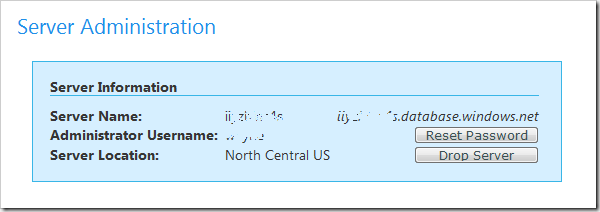A Server Is Not a Machine
[This article was contributed by the SQL Azure team.]
I see this come up from time to time, so I thought I would set the record straight; a server isn’t a machine. In SQL Azure, there is a concept of a server, which appears in the SQL Azure portal looking like this:
However, a server isn’t the same as a server in an on-premise SQL Server installation. In an on-premise SQL Server installation a server is synonymous with a machine, which has a fixed set of resources, storage, and hence can hold a limited number of databases.
With SQL Azure, a server is a TDS endpoint. Each of the databases created under that server are spread across multiple machines in the data center. A server in SQL Azure has unlimited capacity to hold additional databases, and has the full resources of the data center. In other words, there is no way for your SQL Azure server to run out of resources.
Another way to think about it is that you don’t have to create new servers in the data center in order to distribute your database load; SQL Azure does it automatically for you. With an on-premise SQL Server installation, the concepts of load balancing and redundancy require that you take the number of servers in consideration. With SQL Azure, one server will provide you with all the load balancing and redundancy you need in the data center.
A single SQL Azure server doesn’t mean a single point of failure; the TDS endpoints are serviced by multiple redundant SQL Azure front-end servers.
SQL Azure Front -End
The SQL Azurefront-end servers are the Internet-facing machines that expose the TDS protocol over port 1433. In addition to acting as the gateway to the service, these servers also provide some necessary customer features, such as account provisioning, billing, and usage monitoring. Most importantly, the servers are in charge of routing requests to the appropriate back-end server. SQL Azuremaintains a directory that keeps track of where on the SQL Azureback-end servers your primary data and all the backup replicas are located. When you connect to SQL Azure, the front end looks in the directory to see where your database is located and forwards the request to that specific back-end node (your database).
Unlimited Databases
Conceptually, there is no limit to the number of databases you can have under a SQL Azure server. However, by default, a SQL Azure account is restricted to 150 databases in each SQL Azure server, including the master database. An extension of this limit is available for your SQL Azure server. For more information, contact a customer support representative at the Microsoft Online Services Customer Portal.
Summary
Do you have questions, concerns, comments? Post them below and we will try to address them.
